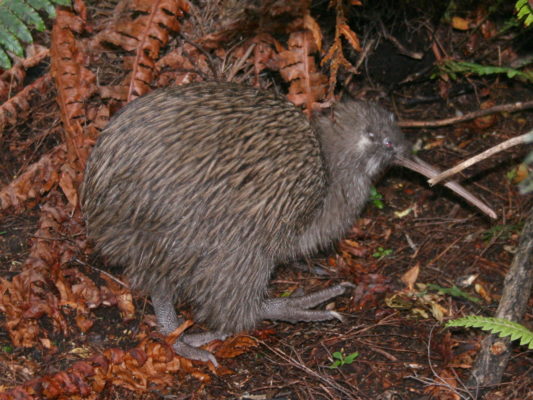How much trapping does it take to make a difference? Sometimes even a small difference can make all the difference to a species that is at a borderline point for sustaining its population.

In a recent edition of the New Zealand Ornithological Society’s journal Notornis, DOC scientists Jane Tansell, Hannah Edmonds and Hugh Robertson reported on a 15,000 hectare low-intensity stoat trapping network in Fiordland’s Murchison Mountains and whether benefits could be demonstrated for tokoeka (southern brown kiwi).
“The southern brown kiwi or tokoeka (Apteryx australis) is a flightless, nocturnal bird that is confined to the mountains just south of Haast, in Fiordland from the Hollyford Valley to Preservation Inlet, and on Stewart Island. In 2008, the total population was estimated at c.30,000 birds, of which about half were in Fiordland. The Fiordland population of tokoeka has a threat ranking of ‘Nationally Vulnerable’ based on an assumed decline of 2% per annum, which equates to a 60% decline over 3 generations (45 years).
The main threats to kiwi nationally are predation – especially by dogs, ferrets, stoats and cats. But in the case of tokoeka living in the Murchison Mountains, dogs, ferrets and cats are absent or only present in very low numbers and stoats are the only introduced mammal to pose a serious threat to them – and it is young kiwi, less that 1kg in weight which are most at risk. Once they are 6-8 months of age, tokoeka are usually big enough to defend themselves from a stoat.
But it wasn’t kiwi that were the intended beneficiaries when a stoat trapping network was established in the mountains. Another, even rarer bird also makes the Murchison Mountains its home.

“A 15,000 ha low-intensity stoat (Mustela erminea) trapping network was established in the Murchison Mountains in 2002, primarily to protect the last natural population of the critically endangered takahe (Porphyrio hochstetteri). We compared the productivity and survival of threatened southern brown kiwi or tokoeka (Apteryx australis) living in 3 valleys that were covered by this trapping network with those in a nearby valley that was left untreated.”
When you’re a Nationally Vulnerable species, there may be benefits in having a few Critically Endangered neighbours living in your ‘hood. The large-scale trapping network was, however low intensity, particularly in the early years.
“From 2002 to 2008, 720 double-set trap boxes were operational (an average density of 1 trap box per 21 ha). Due to their success in helping to protect adult and young takahe, a further 1025 double-set trap boxes were added in 2008/09 to cover the entire 51,000 ha peninsula, giving a total of 1745 trap boxes at an average density of 1 box per 29 ha. Since 2015, the trap density has been doubled to an average density of 1 box per 14 ha. This is a slightly lower intensity compared with many other stoat trapping programmes in New Zealand, but is the largest stoat control programme in the world and a remarkable achievement given the very difficult terrain.”
So what impact has the world’s largest stoat control programme had?
“Chick survival to 6 months old was significantly higher in the trapped areas (37%) than in the untrapped area (19%). This doubling of chick survival was sufficient to change the rate of population growth, as derived from Leslie matrix analyses, from a projected decline of 1.6% per annum without management to a projected increase of 1.2% per annum with trapping.”
It’s an impressive effort and good to know that both takahe and their tokoeka are benefitting as a result. A 1.2% growth in kiwi numbers may not sound huge but it’s a whole lot better than a 1.6% decline. Every bit helps.
The full report is published in Notornis and is freely available online.

